+ Open data
Open data
- Basic information
Basic information
| Entry | Database: PDB / ID: 4im8 | ||||||
|---|---|---|---|---|---|---|---|
| Title | low resolution crystal structure of mouse RAGE | ||||||
 Components Components | Advanced glycation end-products receptor | ||||||
 Keywords Keywords | SIGNALING PROTEIN / heparan sulfate | ||||||
| Function / homology |  Function and homology information Function and homology informationpositive regulation of signaling / advanced glycation end-product binding / Advanced glycosylation endproduct receptor signaling / negative regulation of blood circulation / positive regulation of endothelin production / regulation of CD4-positive, alpha-beta T cell activation / negative regulation of signaling / glucose mediated signaling pathway / positive regulation of monocyte extravasation / regulation of T cell mediated cytotoxicity ...positive regulation of signaling / advanced glycation end-product binding / Advanced glycosylation endproduct receptor signaling / negative regulation of blood circulation / positive regulation of endothelin production / regulation of CD4-positive, alpha-beta T cell activation / negative regulation of signaling / glucose mediated signaling pathway / positive regulation of monocyte extravasation / regulation of T cell mediated cytotoxicity / TRAF6 mediated NF-kB activation / positive regulation of DNA-templated DNA replication / negative regulation of long-term synaptic depression / positive regulation of dendritic cell differentiation / regulation of p38MAPK cascade / TAK1-dependent IKK and NF-kappa-B activation / transcytosis / astrocyte development / induction of positive chemotaxis / positive regulation of monocyte chemotactic protein-1 production / positive regulation of heterotypic cell-cell adhesion / S100 protein binding / positive regulation of p38MAPK cascade / regulation of long-term synaptic potentiation / protein localization to membrane / regulation of spontaneous synaptic transmission / negative regulation of connective tissue replacement involved in inflammatory response wound healing / negative regulation of interleukin-10 production / positive regulation of double-strand break repair / response to amyloid-beta / negative regulation of long-term synaptic potentiation / positive regulation of activated T cell proliferation / phagocytosis / transport across blood-brain barrier / phagocytic cup / positive regulation of chemokine production / positive regulation of interleukin-12 production / astrocyte activation / negative regulation of cell migration / positive regulation of interleukin-1 beta production / positive regulation of JNK cascade / microglial cell activation / positive regulation of non-canonical NF-kappaB signal transduction / positive regulation of interleukin-6 production / fibrillar center / cellular response to amyloid-beta / neuron projection development / positive regulation of tumor necrosis factor production / cell junction / signaling receptor activity / heparin binding / amyloid-beta binding / regulation of inflammatory response / histone binding / learning or memory / response to hypoxia / positive regulation of ERK1 and ERK2 cascade / positive regulation of cell migration / apical plasma membrane / inflammatory response / external side of plasma membrane / protein-containing complex binding / cell surface / DNA binding / RNA binding / extracellular region / identical protein binding / nucleus / plasma membrane Similarity search - Function | ||||||
| Biological species |  | ||||||
| Method |  X-RAY DIFFRACTION / X-RAY DIFFRACTION /  SYNCHROTRON / SYNCHROTRON /  MOLECULAR REPLACEMENT / Resolution: 3.503 Å MOLECULAR REPLACEMENT / Resolution: 3.503 Å | ||||||
 Authors Authors | Xu, D. / Young, J.H. / Krahn, J.M. / Song, D. / Corbett, K.D. / Chazin, W.J. / Pedersen, L.C. / Esko, J.D. | ||||||
 Citation Citation |  Journal: Acs Chem.Biol. / Year: 2013 Journal: Acs Chem.Biol. / Year: 2013Title: Stable RAGE-Heparan Sulfate Complexes Are Essential for Signal Transduction. Authors: Xu, D. / Young, J.H. / Krahn, J.M. / Song, D. / Corbett, K.D. / Chazin, W.J. / Pedersen, L.C. / Esko, J.D. | ||||||
| History |
|
- Structure visualization
Structure visualization
| Structure viewer | Molecule:  Molmil Molmil Jmol/JSmol Jmol/JSmol |
|---|
- Downloads & links
Downloads & links
- Download
Download
| PDBx/mmCIF format |  4im8.cif.gz 4im8.cif.gz | 84.9 KB | Display |  PDBx/mmCIF format PDBx/mmCIF format |
|---|---|---|---|---|
| PDB format |  pdb4im8.ent.gz pdb4im8.ent.gz | 64.1 KB | Display |  PDB format PDB format |
| PDBx/mmJSON format |  4im8.json.gz 4im8.json.gz | Tree view |  PDBx/mmJSON format PDBx/mmJSON format | |
| Others |  Other downloads Other downloads |
-Validation report
| Summary document |  4im8_validation.pdf.gz 4im8_validation.pdf.gz | 425.4 KB | Display |  wwPDB validaton report wwPDB validaton report |
|---|---|---|---|---|
| Full document |  4im8_full_validation.pdf.gz 4im8_full_validation.pdf.gz | 427.4 KB | Display | |
| Data in XML |  4im8_validation.xml.gz 4im8_validation.xml.gz | 9.1 KB | Display | |
| Data in CIF |  4im8_validation.cif.gz 4im8_validation.cif.gz | 11.3 KB | Display | |
| Arichive directory |  https://data.pdbj.org/pub/pdb/validation_reports/im/4im8 https://data.pdbj.org/pub/pdb/validation_reports/im/4im8 ftp://data.pdbj.org/pub/pdb/validation_reports/im/4im8 ftp://data.pdbj.org/pub/pdb/validation_reports/im/4im8 | HTTPS FTP |
-Related structure data
| Related structure data |  3cjjS S: Starting model for refinement |
|---|---|
| Similar structure data |
- Links
Links
- Assembly
Assembly
| Deposited unit | 
| ||||||||
|---|---|---|---|---|---|---|---|---|---|
| 1 | x 6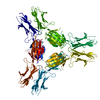
| ||||||||
| 2 | 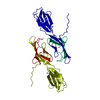
| ||||||||
| 3 | x 6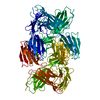
| ||||||||
| Unit cell |
|
- Components
Components
| #1: Protein | Mass: 22926.318 Da / Num. of mol.: 1 Source method: isolated from a genetically manipulated source Source: (gene. exp.)   |
|---|---|
| Has protein modification | Y |
-Experimental details
-Experiment
| Experiment | Method:  X-RAY DIFFRACTION / Number of used crystals: 1 X-RAY DIFFRACTION / Number of used crystals: 1 |
|---|
- Sample preparation
Sample preparation
| Crystal | Density Matthews: 2.82 Å3/Da / Density % sol: 56.43 % |
|---|---|
| Crystal grow | Temperature: 298 K / Method: vapor diffusion, hanging drop / pH: 8.5 Details: 0.1M Tris pH 8.5, 200mM MgCl2 and 22% PEG 400. Protein was purified on gel filtration in the presence of excess dodecasaccharide heparan sulfate that caused a shift in the elution profile ...Details: 0.1M Tris pH 8.5, 200mM MgCl2 and 22% PEG 400. Protein was purified on gel filtration in the presence of excess dodecasaccharide heparan sulfate that caused a shift in the elution profile from monomer to hexamer, VAPOR DIFFUSION, HANGING DROP, temperature 298K |
-Data collection
| Diffraction | Mean temperature: 100 K |
|---|---|
| Diffraction source | Source:  SYNCHROTRON / Site: SYNCHROTRON / Site:  APS APS  / Beamline: 22-ID / Wavelength: 1 Å / Beamline: 22-ID / Wavelength: 1 Å |
| Detector | Type: MARMOSAIC 300 mm CCD / Detector: CCD / Date: Aug 4, 2012 |
| Radiation | Monochromator: Sagitally Focused Si 220 / Protocol: SINGLE WAVELENGTH / Monochromatic (M) / Laue (L): M / Scattering type: x-ray |
| Radiation wavelength | Wavelength: 1 Å / Relative weight: 1 |
| Reflection | Resolution: 3.5→50 Å / Num. all: 3672 / Num. obs: 3672 / % possible obs: 99.5 % / Observed criterion σ(F): 48106 / Observed criterion σ(I): 48106 / Redundancy: 13.1 % / Rsym value: 0.107 / Net I/σ(I): 8.1 |
| Reflection shell | Resolution: 3.5→3.63 Å / Redundancy: 12.2 % / Mean I/σ(I) obs: 4 / Num. unique all: 348 / Rsym value: 0.702 / % possible all: 100 |
- Processing
Processing
| Software |
| ||||||||||||||||||||||||||||||||||||||||||||||||||||||||||||||||||||||||||||||||||||||||||||||||
|---|---|---|---|---|---|---|---|---|---|---|---|---|---|---|---|---|---|---|---|---|---|---|---|---|---|---|---|---|---|---|---|---|---|---|---|---|---|---|---|---|---|---|---|---|---|---|---|---|---|---|---|---|---|---|---|---|---|---|---|---|---|---|---|---|---|---|---|---|---|---|---|---|---|---|---|---|---|---|---|---|---|---|---|---|---|---|---|---|---|---|---|---|---|---|---|---|---|
| Refinement | Method to determine structure:  MOLECULAR REPLACEMENT MOLECULAR REPLACEMENTStarting model: 3CJJ Resolution: 3.503→23.162 Å / SU ML: 0.39 / σ(F): 1.34 / Phase error: 36.42 / Stereochemistry target values: ML
| ||||||||||||||||||||||||||||||||||||||||||||||||||||||||||||||||||||||||||||||||||||||||||||||||
| Solvent computation | Shrinkage radii: 0.9 Å / VDW probe radii: 1.11 Å / Solvent model: FLAT BULK SOLVENT MODEL | ||||||||||||||||||||||||||||||||||||||||||||||||||||||||||||||||||||||||||||||||||||||||||||||||
| Refinement step | Cycle: LAST / Resolution: 3.503→23.162 Å
| ||||||||||||||||||||||||||||||||||||||||||||||||||||||||||||||||||||||||||||||||||||||||||||||||
| Refine LS restraints |
| ||||||||||||||||||||||||||||||||||||||||||||||||||||||||||||||||||||||||||||||||||||||||||||||||
| Refinement TLS params. | S33: 0 Å ° / Method: refined / Refine-ID: X-RAY DIFFRACTION
| ||||||||||||||||||||||||||||||||||||||||||||||||||||||||||||||||||||||||||||||||||||||||||||||||
| Refinement TLS group |
|
 Movie
Movie Controller
Controller



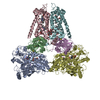
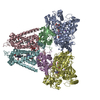




 PDBj
PDBj








